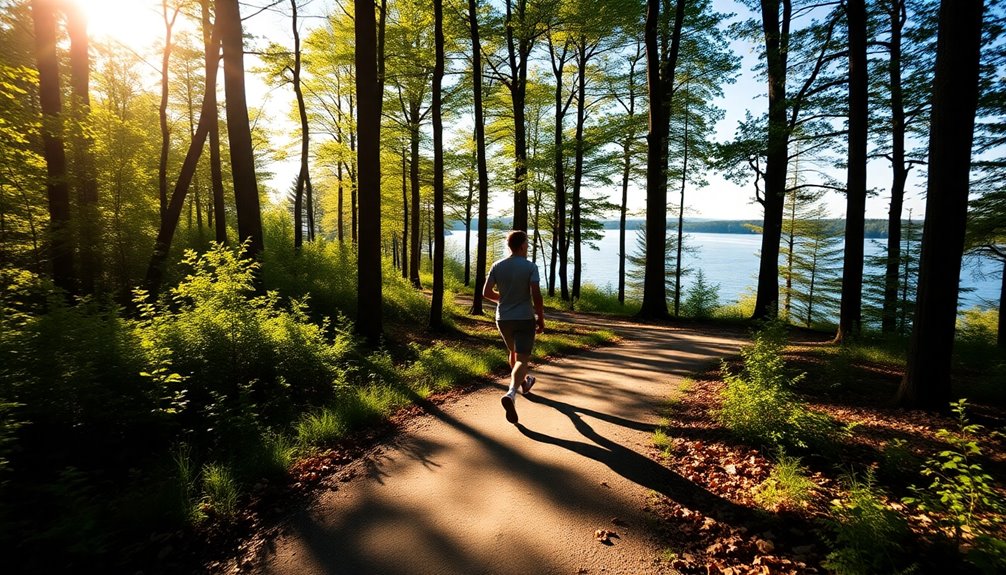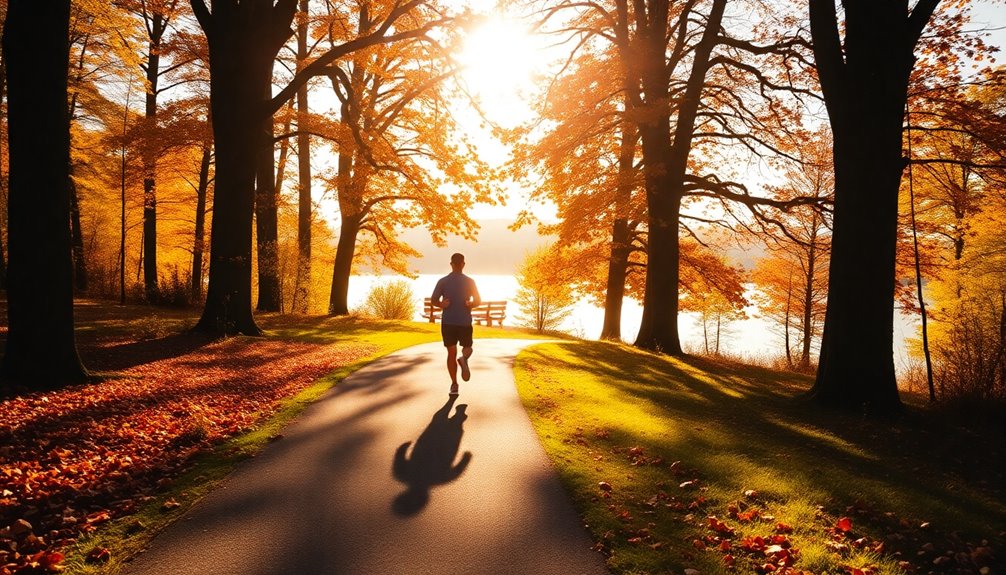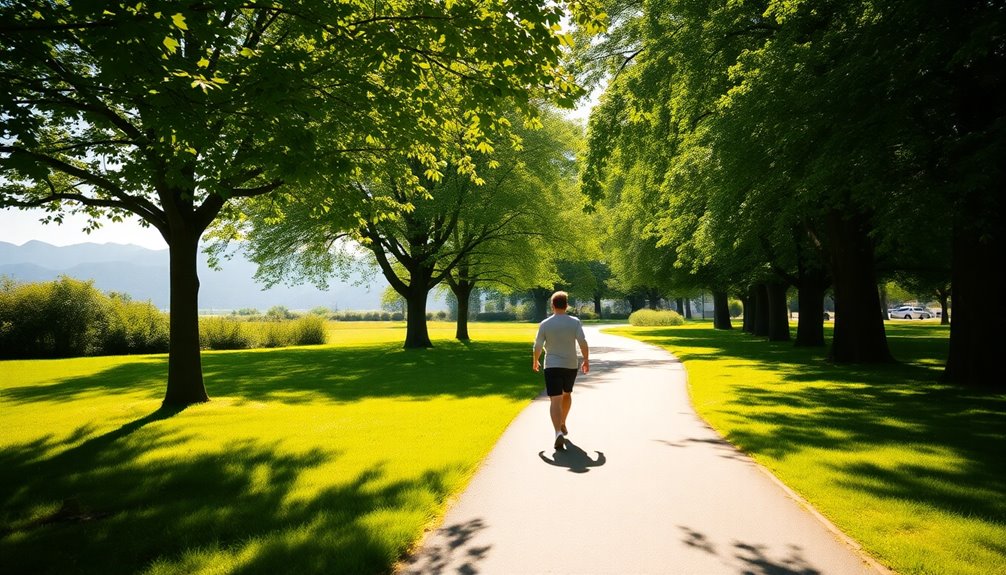Walking alone isn't just exercise; it's a powerful routine that benefits both your mind and body. You can experience lower anxiety and improved mood as walking releases endorphins, acting like a natural antidepressant. Physically, it enhances cardiovascular health and aids in weight management. As you walk, you gain a chance for reflection and mindfulness, fostering emotional resilience. You can start with short walks, gradually increasing your time for greater benefits. Plus, engaging in this solitary practice can boost your creativity and focus. Discover how to make the most of your solo walks and uncover more hidden advantages.
Benefits of Walking Alone
Walking alone offers a unique opportunity to enhance your mental well-being while enjoying physical activity. When you take solitary walks, you create a space for personal reflection and mindfulness, which can greatly reduce anxiety and depression. This quiet time allows you to connect with your thoughts, leading to improved mental health. Additionally, utilizing budget apps can help track your progress and support your overall financial well-being. Furthermore, engaging in regular exercise, such as walking, can contribute to your investment health by promoting a healthy lifestyle.
Moreover, walking by yourself can spark creativity. Studies show that this form of exercise promotes divergent thinking, helping you generate innovative ideas and solutions. You're free to set your own pace and distance, allowing you to focus entirely on your journey without the influence of a companion.
The physical activity involved in walking alone releases endorphins, which boosts your mood and emotional well-being, giving you a sense of accomplishment and satisfaction. Think of your solitary walks as a form of meditation; they offer a chance to disconnect from distractions and re-center yourself.
This reconnection ultimately promotes better mental clarity and focus. In a world full of noise, walking alone becomes a rejuvenating retreat, providing you the mental and emotional space you need to thrive. Additionally, incorporating tracking progress into your routine can further enhance your overall well-being and help you achieve your personal goals.
Mental Health Improvements
Stepping into solitude offers profound mental health improvements that can greatly enhance your overall well-being. When you walk alone, you're not just exercising your body; you're also nurturing your mind.
Regular solitary walks can reduce symptoms of anxiety and depression by releasing endorphins, which elevate your mood. Research shows that brisk walking for at least 30 minutes five times a week boosts mental clarity and reduces fatigue. Additionally, engaging in AI-driven recommendations can help identify the best walking routes tailored to your preferences. Walking can also be an effective way to manage personal budgets, as it encourages reflection on your financial goals while enjoying nature.
Consider these benefits of walking alone:
- Enhanced Problem-Solving: Introspection during your walk can lead to innovative thinking and better decision-making.
- Increased Creativity: Studies link walking to improved creativity, allowing ideas to flow freely.
- Boosted Self-Esteem: Consistent walkers often report higher self-worth and life satisfaction.
- Stress Reduction: Nature walks lower cortisol levels, promoting calmness and mental resilience.
- Better Emotional Well-Being: Engaging in regular walks has a lasting positive impact on your emotional state. Additionally, participating in eco-friendly practices while walking can enhance your overall mindfulness and connection to nature.
Physical Health Advantages

Often overlooked, the physical health advantages of walking alone can have a significant impact on your overall fitness. When you engage in solo walks, you're not just enjoying fresh air; you're also boosting your cardiovascular health. Studies show that regular walkers experience lower blood pressure and a reduced risk of heart disease. Additionally, incorporating walking into your routine can help you establish a proactive monitoring of due dates for bills, ensuring you stay organized and timely in your financial commitments.
Walking briskly for at least 150 minutes a week can help you burn approximately 1,000 calories, making it a great tool for weight management and enhancing your metabolism. Furthermore, walking aids in recovery from workouts, improving your overall physical fitness and performance. Engaging in regular physical activity, such as walking, can also lead to improved financial management as you may find yourself more focused and organized in your daily tasks.
If you're concerned about blood sugar levels, consider taking 10-minute walks after meals. This simple habit can control glucose levels and lower your risk of type 2 diabetes.
Additionally, the benefits of walking extend to your sleep quality. Consistent walking is linked to longer sleep duration and improved sleep patterns, helping combat insomnia and other sleep disorders. Incorporating regular walks can also enhance your overall financial literacy, as educational resources on budgeting apps can help you better manage your financial health while enjoying the benefits of physical activity.
Creating Your Walking Routine
To create an effective walking routine, start with short walks of 10-15 minutes and gradually increase your time as you build endurance.
Set achievable goals to keep you motivated and track your progress. Utilizing tools like budgeting apps can help you set financial goals that complement your walking routine. Engaging with your budget through structured approaches can enhance your overall financial well-being, making it easier to invest in your health. Additionally, establishing a structured framework for your finances can lead to better health and wellness outcomes.
Don't forget to add some fun by listening to music or podcasts while you walk, making the experience more enjoyable.
Start With Short Walks
Starting your walking routine with short walks of 10-15 minutes can make all the difference in building endurance while minimizing the risk of injury. By beginning with manageable durations, you allow your body to adapt without overwhelming it.
As you feel more comfortable, you can gradually build up to longer walks of 30-45 minutes, covering a total distance of 2-4 miles for ideal health benefits.
To enhance your walking experience and stay motivated, consider these tips:
- Incorporate stretching exercises before and after your walks to improve flexibility.
- Choose scenic routes to make your walks more enjoyable and engaging.
- Listen to music or podcasts while walking to uplift your mood.
- Set specific days for walking to create a consistent routine.
- Celebrate your progress regularly to maintain motivation.
Set Achievable Goals
Setting achievable goals is essential for creating a successful walking routine that fits your lifestyle. Start by committing to at least 30 minutes of walking each day. As your endurance improves, gradually increase this duration to challenge yourself further. Aiming for a target of 10,000 steps daily can greatly benefit your cardiovascular health and boost your mood.
To make your daily walks more manageable, consider breaking them into segments. For example, three 10-minute walks throughout the day can easily fit into your busy schedule. This way, you won't feel overwhelmed, and you'll still reap the benefits of consistent movement.
Celebrate small milestones, like completing a week of consistent walks. Recognizing these achievements keeps you motivated and reinforces your commitment to your walking routine.
Additionally, use specific benchmarks, such as walking 2-4 miles or tracking steps per week, to monitor your progress. These metrics help you adjust your goals as needed, ensuring that you continually set achievable goals that push you without causing burnout.
Incorporate Fun Activities
Incorporating fun activities into your walking routine can elevate the experience and keep you motivated. By blending enjoyment with exercise, you not only enhance your physical fitness but also enjoy significant mental benefits.
Here are some ideas to spice up your walks:
- Listen to upbeat music or engaging podcasts to keep your energy high.
- Invite friends or family to join you; the social interaction can make your walks more enjoyable.
- Explore new routes in parks, nature reserves, or urban trails to keep things fresh and exciting.
- Set mini-challenges along the way, like increasing your pace for short bursts or counting steps to add an element of fun.
- Celebrate your milestones—recognizing your achievements can motivate you to walk more regularly.
Safety Tips for Solo Walks

When you head out for a solo walk, safety should be a top priority.
Wear bright clothing to increase your visibility, especially in low-light conditions, and always choose safe, well-lit routes. AI can help you analyze advanced trend analysis on popular walking routes in your area, ensuring you stay informed about any potential safety concerns as you enjoy your walk. Additionally, utilizing automated notifications for other responsibilities can help keep your mind focused on your surroundings while walking.
Before you leave, let someone know your plans to guarantee an extra layer of security while you enjoy your walk. Additionally, consider using AI-driven tools to help plan your route and stay informed about any potential safety concerns in the area.
Wear Bright Clothing
To guarantee your safety while walking alone, wearing bright clothing is essential. High-visibility attire not only makes you more noticeable to drivers and pedestrians, but it also enhances your overall safety during your walks.
Studies reveal that wearing bright colors can decrease the likelihood of pedestrian accidents by up to 40%.
Here are some practical tips for choosing the right clothing:
- Opt for neon or fluorescent colors for maximum visibility.
- Incorporate reflective materials, especially if you walk at night.
- Choose clothing that fits comfortably, allowing you to move freely.
- Add reflective accessories, like bands or vests, for an extra safety boost.
- Regularly check your gear to verify it's in good condition.
Choose Safe Routes
Choosing safe routes is vital for your well-being while walking alone. Prioritize well-lit and populated areas, especially during early mornings or evenings, to enhance safety and visibility. Familiarize yourself with your surroundings and stick to routes you know well. This helps reduce the risk of accidents or encounters with potential dangers.
If you must walk at night, wear brightly colored clothing and use reflectors to guarantee you're visible to others, especially drivers. It's essential to avoid isolated or unfamiliar areas where safety may be compromised.
Always carry a charged mobile phone with emergency contacts easily accessible. This way, you can summon help if needed. Remember, the activity of walking alone should feel empowering, not intimidating. By taking these precautions, you create a safer environment for yourself while enjoying the numerous benefits of walking.
Maintaining awareness of your surroundings is also key. Stay off your phone and be present during your walk.
Inform Someone Beforehand
Before you head out for a solo walk, it's vital to inform someone about your plans. This simple step can greatly enhance your safety and provide peace of mind. If something goes awry, having someone aware of your whereabouts can make a difference.
Here are some tips to ponder:
- Share your intended walking route and estimated return time.
- Use a smartphone app that allows loved ones to track your location.
- Stick to well-lit and populated areas to reduce risks.
- Carry a fully charged phone with emergency contacts saved.
- If you're walking at night, wear reflective clothing and carry a flashlight.
These precautions guarantee that if you need help, someone knows where to find you.
Walking alone can be a liberating experience, but it's important to prioritize your safety. By taking these steps, you can enjoy your time outdoors while staying connected and protected.
Enhancing Mood Through Movement
Walking alone offers a unique blend of physical activity and mental rejuvenation that can greatly lift your spirits. When you step outside for a walk, your body releases endorphins, the natural mood lifters that boost your emotional well-being. This simple form of exercise not only elevates your mood but also helps reduce stress by lowering cortisol levels, making it easier to cope with daily challenges.
Engaging in regular walking routines can considerably decrease symptoms of anxiety and depression. Research shows that individuals who walk for at least 30 minutes most days report higher happiness and life satisfaction. The consistency of this activity fosters a sense of achievement, enhancing your self-efficacy and promoting a more positive outlook on life.
Walking in natural settings, even when you're alone, amplifies these benefits. It connects you with your surroundings, leading to a more uplifting mental state.
Walking and Creativity Boost

Numerous studies highlight how walking can greatly boost your creativity. The Stanford Walking Study in 2014 revealed that engaging in walking markedly enhances your creative thinking, especially divergent thinking, which leads to innovative ideas.
Whether you choose to walk indoors or outdoors, this simple act can stimulate your cognitive processes effectively.
Walking encourages you to explore unconventional ideas, just as great thinkers like Tchaikovsky and Einstein did. The tranquility of nature during outdoor walks has been found to amplify creative thinking, allowing for mental rejuvenation and fresh perspectives.
Here are some key benefits of walking related to your creativity boost:
- Sparks innovative ideas and solutions
- Enhances focus and cognitive flexibility
- Promotes mental liberation from routine thinking
- Encourages exploration of new concepts
- Provides a break from traditional workspaces
Incorporating Walking Into Daily Life
Incorporating walking into your daily life can be easy and rewarding.
You can create daily walking habits by choosing creative routes or simply opting for stairs over elevators.
Daily Walking Habits
How can you seamlessly weave walking into your daily routine? It's easier than you think! By making small changes, you can effortlessly incorporate regular physical activity into your life. Aim for at least 30 minutes of moderate-intensity walking five days a week, aligning with the recommended 150 minutes of exercise for adults.
Here are some practical tips to get you started:
- Choose stairs instead of elevators.
- Walk partway to work or the store.
- Take short 10-minute walks after meals to aid digestion.
- Organize walking meetings to stay active and engaged.
- Use apps like Active 10 to track your progress and set goals.
These simple adjustments can greatly boost your daily activity levels. Not only do they help you meet your exercise goals, but they also enhance your overall well-being.
By incorporating walking into your daily routines, you'll enjoy the benefits of increased energy, improved mood, and better health. Remember, walking doesn't have to be a chore; it's a simple yet powerful way to stay fit and connected to your environment.
Creative Walking Routes
Finding creative walking routes can transform your daily routine into an enjoyable adventure. Incorporate walking routes into your commute by choosing to walk partway to work or school. This adds essential physical activity without taking extra time from your busy schedule.
Explore local parks, heritage trails, and riverside paths to make your walks visually stimulating and enjoyable, boosting your physical and mental well-being.
Use everyday errands as chances for short walks. Park further away from stores or opt to walk instead of drive for nearby trips. This helps integrate movement naturally into your routine and supports an active lifestyle.
Join a community walking group or participate in organized walks with the Ramblers organization to discover new routes while connecting with others and staying motivated.
To keep things fresh, mix up your walking routes regularly. Visit different environments like woodlands, heaths, or nature reserves to break the monotony and engage your senses.
Walking Protocols for Success

Establishing effective walking protocols can greatly enhance your health and well-being. By incorporating specific strategies into your routine, you can experience a positive impact on both your physical and mental health.
Here are some walking protocols for success to evaluate:
- Post-meal walks: Take short 10-minute walks after meals to help control blood sugar levels and improve digestion.
- Weekly goals: Aim for 150 minutes of moderate-intensity walking each week, ideally 30 minutes a day for five days—great for cardiovascular health.
- Break up sedentary time: Stand up and walk for a few minutes every hour to promote better circulation and combat metabolic syndrome.
- Rucking: Carry a weighted backpack while walking to intensify your workout and boost muscle strength.
- Change your scenery: Walk in a park or nature reserve after meals to reduce cravings and enhance mental clarity.
Alternative Exercises and Movement
If you're looking for creative movement alternatives, consider incorporating functional exercises into your routine.
Activities like calf flexing or rucking can effectively boost your fitness without needing a gym.
Creative Movement Alternatives
Exploring creative movement alternatives can breathe new life into your fitness routine, allowing you to stay active without the monotony of traditional walking.
By incorporating these options, you'll find that physical activity can help enhance both your physical and mental well-being.
- Calf Flexing/Soleus Push-ups: Engage in these exercises to boost blood flow, potentially offering metabolic benefits equivalent to 10,000 steps per week.
- Rucking: Carry a weighted backpack while walking to elevate your heart rate and build muscular strength.
- Water Aerobics: Enjoy a low-impact workout that strengthens muscles while minimizing strain on your joints, perfect for those with mobility concerns.
- Desk Exercises: Perform leg lifts and calf raises throughout the day to counteract the effects of prolonged sitting and keep your body moving.
- Active Commuting: Bike or walk part of the way to work, seamlessly integrating physical activity into your daily routine.
These creative movement alternatives not only keep your workouts fresh but also help you stay committed to a healthier lifestyle.
Incorporating Functional Exercises
Incorporating functional exercises into your walking routine not only boosts your strength but also enhances your mobility, making each step more effective. You can easily integrate bodyweight squats and lunges during your walking breaks. These exercises complement the cardio benefits of walking, allowing you to improve your fitness level considerably.
While walking, try adding calf raises or heel lifts. These movements promote blood flow and activate your lower leg muscles, contributing to your overall fitness. If you want to challenge yourself further, consider rucking—walking with a weighted backpack. This simple adjustment can increase your heart rate and improve strength, making your walking routine even more effective.
Don't forget about dynamic stretches! Incorporate arm circles or leg swings before and after your walks to enhance flexibility and reduce your risk of injury.
Additionally, combining walking with mobility exercises like hip openers or torso twists can improve your joint function, further enhancing the effectiveness of your routine.
Building Endurance With Walking

Building endurance with walking is a rewarding journey that can lead to significant improvements in your overall fitness. By gradually increasing your walking duration and intensity, you can effectively build endurance and enhance cardiovascular fitness. Aim for 30-45 minute exercise sessions, covering 2-4 miles at a brisk pace of about 3 miles per hour.
Here are some tips to boost your endurance:
- Start with short 10-minute walks to ease into your routine.
- Gradually extend your walking time and distance each week.
- Incorporate rucking by adding weights to increase your heart rate and strength.
- Set a goal of at least 150 minutes of moderate-intensity walking per week.
- Track your progress to stay motivated and recognize improvements.
As you commit to these strategies, you'll notice your stamina and overall physical well-being improving.
Walking alone not only allows you to build endurance but also offers a chance to clear your mind and enjoy your surroundings. Embrace this journey, and you'll find that each step takes you closer to your fitness goals.
The Importance of Consistency
Walking alone can be a powerful way to clear your mind and focus on your fitness goals. One of the key elements to achieving those goals is consistency. By committing to a walking routine, you're not just exercising; you're actively investing in your cardiovascular health.
Studies show that walking at least 150 minutes a week can lead to significant improvements in heart health. To maximize the benefits, aim for at least 7,500 steps daily. This simple yet effective target can support weight loss and improve your sleep quality.
It's crucial to engage in walking at least five days a week, as this aligns with physical activity guidelines recommended by health authorities. When you establish a consistent walking routine, you enhance your endurance and overall fitness.
You'll notice better recovery from workouts and improvements in metabolic health over time. Additionally, the mental health benefits—like reduced anxiety and boosted mood—compound with regular practice, making every step you take count.
Overcoming Barriers to Walking

While many people want to incorporate walking into their daily routines, various barriers can stand in the way. You might struggle with lack of time, worry about injuries, or feel self-conscious.
Overcoming barriers to walking is essential for reaping the positive effects of this simple exercise. Here are some strategies to help you:
- Set achievable goals: Start small with short walks, gradually increasing duration.
- Dress for success: Invest in layers and waterproof gear to tackle weather challenges.
- Utilize technology: Use apps like Active 10 to track your progress and set reminders.
- Join a community: Find local walking groups for social support and motivation.
- Embrace short bursts: Remember that even 10 minutes of walking can boost your mood.
Embracing the Solitude of Walking
Many people underestimate the power of embracing solitude during a walk. When you engage in solitary walking, you give yourself the chance to process your thoughts and emotions without distractions. This mindful time allows you to reflect deeply, fostering a sense of clarity that often eludes you in the hustle of daily life.
Studies show that walking alone can spark creativity, enhancing your ability to think divergently and generate innovative ideas. Nature plays an essential role in this; walking in natural settings has been linked to improved mental health, greatly reducing anxiety and stress. The calming effects of nature help center your mind and elevate your mood.
Moreover, solitary walks serve as an act of self-care, empowering you by allowing you to set your own pace and choose your route. This independence can boost your confidence and enhance your focus.
Many individuals report feeling more productive and mentally alert after their solo walks.
Conclusion
Walking alone isn't just a physical activity; it's a transformative experience for your mind and body. Imagine this: Sarah, a busy mom, finds peace during her daily walks, which helps her manage stress and boosts her mood. Embracing solitude, she discovers clarity in her thoughts and a renewed sense of self. By committing to this simple routine, you too can access the powerful benefits of walking alone—improving your mental health, building endurance, and finding joy in your own company.



